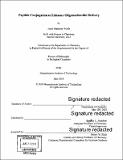Peptide conjugation to enhance oligonucleotide delivery
Author(s)
Wolfe, Justin Mahoney
DownloadFull printable version (50.40Mb)
Other Contributors
Massachusetts Institute of Technology. Department of Chemistry.
Advisor
Bradley L. Pentelute.
Terms of use
Metadata
Show full item recordAbstract
The intracellular delivery of functional macromolecules remains an outstanding challenge in biomedicine. While small molecules can diffuse through the plasma membrane, many large therapeutic molecules are not internalized to an appreciable extent. One strategy to improve cell uptake involves linking the molecule of interest to a cell-penetrating peptide (CPP). CPPs are widely employed to enhance macromolecule delivery, with hundreds of different peptides and modifications reported to improve cellular uptake. In this thesis, CPPs were systematically investigated and chemically altered to facilitate the delivery of antisense oligonucleotides. To accurately compare the existing CPPs, 64 CPP sequences were synthesized, conjugated to oligonucleotides, and assayed for delivery. These CPPs showed a range of effectiveness, with some CPPs hindering the delivery of oligonucleotide cargo and others leading to a 10-fold increase in oligonucleotide activity. To help identify which CPPs might be valuable for oligonucleotide delivery specifically, a computational model was developed to predict, de novo, whether or not a CPP will be effective. When experimentally validated, this model successfully predicted which sequences would improve oligonucleotide delivery greater than 3-fold. Multiple strategies were employed to improve CPP effectiveness. First, arginine-rich CPPs were chemically modified with perfluoroarenes. Cyclic and bicyclic CPPs were synthesized by linking multiple cysteine residues together with a perfluoroarene. After oligonucleotide conjugation, these peptides led to a 14-fold increase in delivery. Second, two different CPPs were combined into one long chimeric sequence. The CPP chimeras were highly active, leading to a 20-fold increase in oligonucleotide delivery. Third, the idea of combining multiple CPPs led to the development of a method for the rapid synthesis combinatorial peptide conjugates. Using the judicious choice of bioconjugation chemistry, highly-active modular constructs were synthesized that contain three peptides linked to one oligonucleotide. In addition to CPPs for oligonucleotide delivery, one section of this thesis employed perfluoroaryl macrocyclic peptides to address the challenge of peptide delivery across the blood-brain barrier. An additional section developed a new peptide conjugation strategy that uses palladium-peptide oxidative addition complexes as solid, storable, and water-soluble reagents for bioconjugation.
Description
Thesis: Ph. D. in Biological Chemistry, Massachusetts Institute of Technology, Department of Chemistry, 2018. Cataloged from PDF version of thesis. Includes bibliographical references.
Date issued
2018Department
Massachusetts Institute of Technology. Department of ChemistryPublisher
Massachusetts Institute of Technology
Keywords
Chemistry.